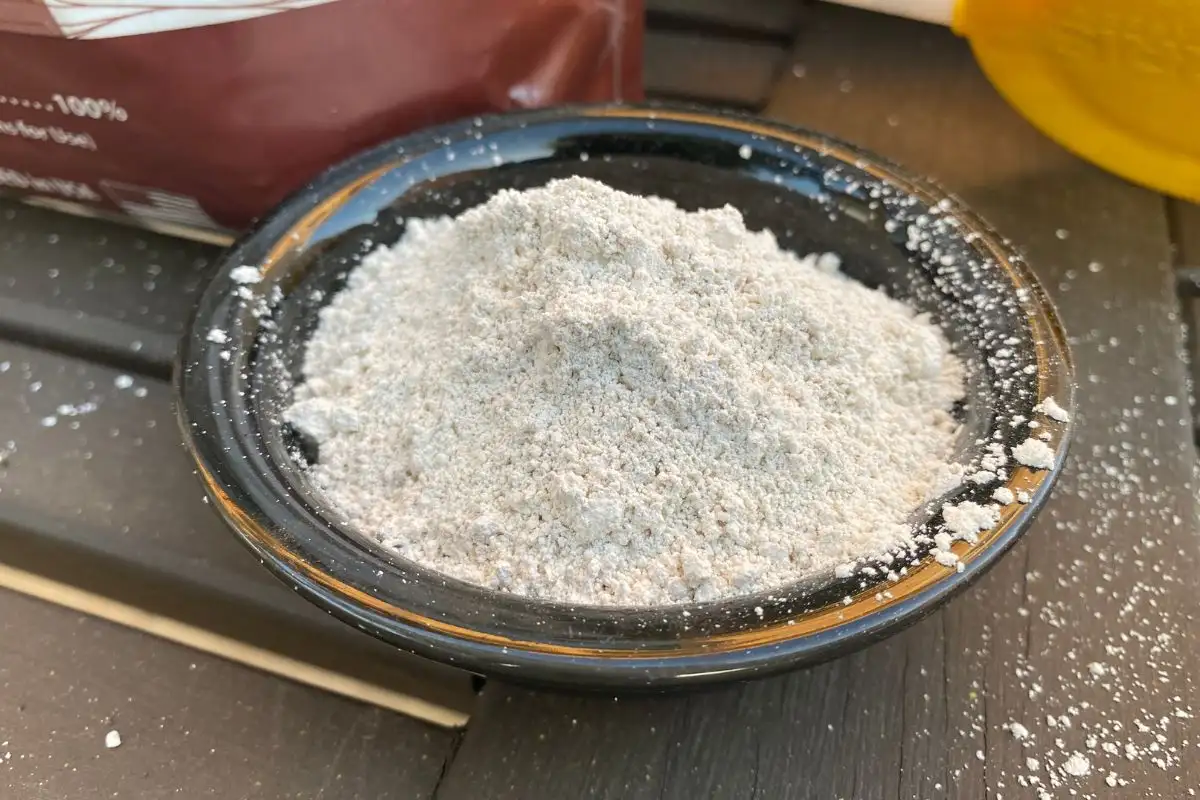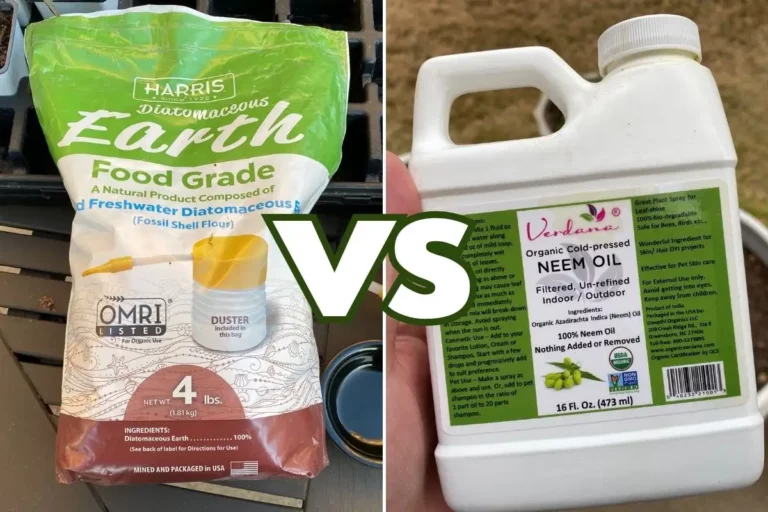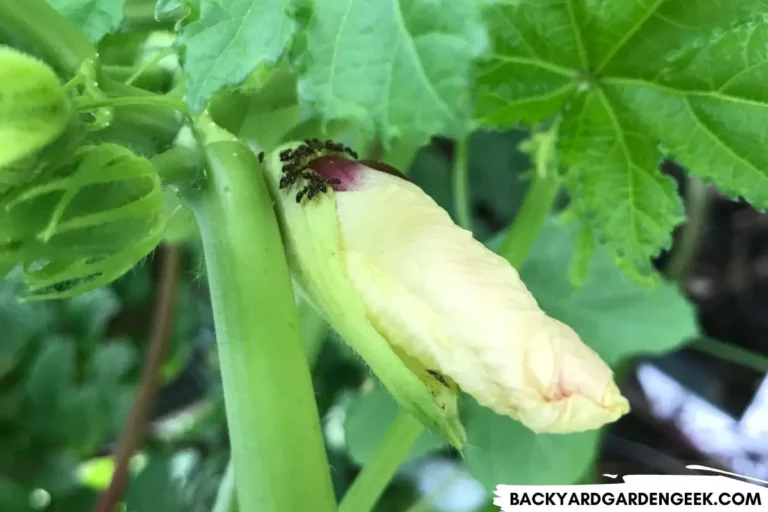Will Diatomaceous Earth Harm or Kill Cucumber Beetles?
As someone who’s lost several plants to cucumber beetles, I know all too well the havoc they can wreak in the garden.
These tiny yet relentless pests can devastate plants, so if you’ve been looking for a natural solution to cucumber beetles, diatomaceous earth (DE) could be the answer you’ve been looking for.
When applied to infested plants, diatomaceous earth will damage cucumber beetles’ exoskeletons, absorbing moisture and causing dehydration and death. But diatomaceous earth must come into direct contact with cucumber beetles; otherwise, it won’t harm them.
One thing’s for sure. You’ve got to address the presence of cucumber beetles in your garden as soon as you spot them!
These beetles not only feed on your plants. Even worse, they carry harmful plant viruses and bacteria, spreading diseases as they feast on one plant after another.
In the article below, I’ll cover these important topics:
- what DE is and what it’s good for
- a step-by-step guide to killing cucumber beetles with DE
- mistakes to avoid when using DE in your garden
I’ll also touch upon alternative methods that can be combined with DE for a comprehensive beetle control strategy.
One quick note: If you want to follow all of my recommendations below (and if you want to avoid problems using DE when it’s slightly windy outside), you’ll want to consider these products or something similar:
Now that I’ve given you a brief overview of what’s to come, let’s get started and save our plants from destructive cucumber beetles!
What’s Diatomaceous Earth, and What Is It Good For?
Diatomaceous earth (DE) is a naturally occurring siliceous material derived from the fossilized remains of diatoms, a type of single-celled algae.
Unlike basically all other organisms on the planet, these tiny diatoms had cellular structures made up of silica, and as countless diatoms went through their life cycles, they formed large deposits as they accumulated in sediment layers.
When mined and ground into a fine powder, DE retains the unique mineral properties that make it an excellent tool for pest control.
The secret behind DE’s effectiveness against pests like cucumber beetles lies in its microscopic structure.
The particles of diatomaceous earth look and feel powdery to humans, mammals, and all other large animal species, but they’re sharp and abrasive to insects, damaging their exoskeletons whenever they come into contact with it.
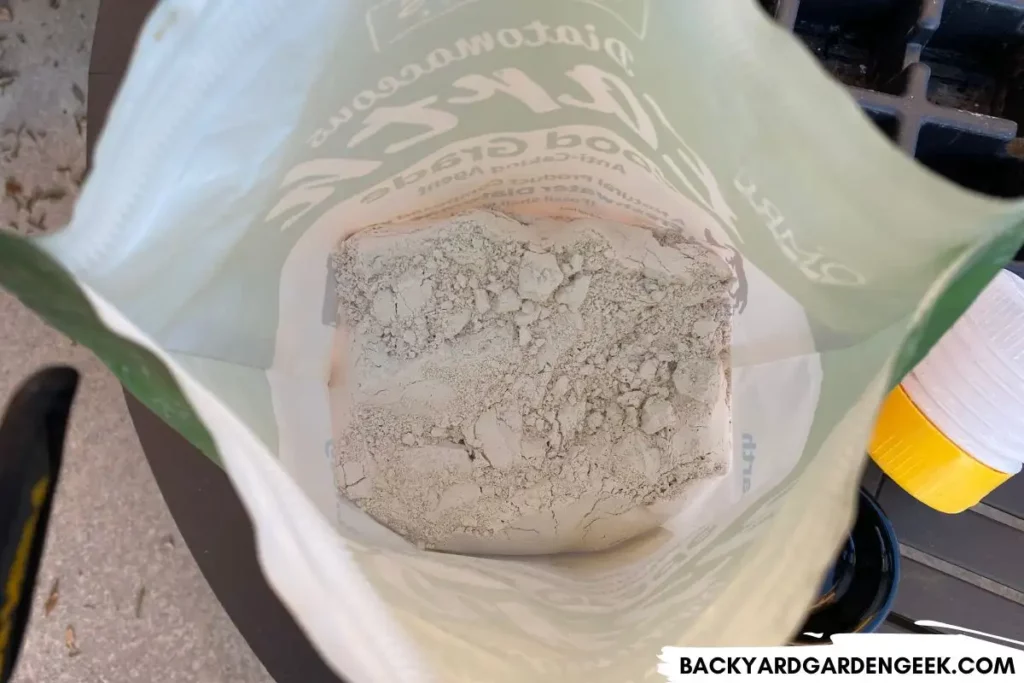
But that’s not all: DE is also highly absorptive, capable of absorbing moisture, fats, and oils from its surroundings.
This dual action—damaging exoskeletons while also absorbing essential body fluids—dehydrates many insects, causing them to die.
As someone who practices organic gardening, I appreciated that DE is not only effective against cucumber beetles but also an eco-friendly and non-toxic option for controlling a variety of garden pests.
Since it’s a natural substance, DE can be safely used around your plants without posing any risk to your or your family’s health (as long as you don’t inhale or ingest it…more on that later).
Now that I’ve covered the DE basics, let’s dive into the specifics of how DE impacts cucumber beetles and how to use it effectively for optimal results.
Diatomaceous Earth and Cucumber Beetles: Will DE Stop Them?
Cucumber beetles, which come in both striped and spotted varieties, may look a bit like ladybugs, but don’t be deceived!
These pests affect plants in the cucurbit family, including cucumbers, melons, and squash. They’ll overwinter in plant debris and emerge in early spring to lay their eggs near the base of host plants.
As cucumber beetle larvae feed on the roots of your plants, they’ll develop into adults and begin feeding on the plant itself.
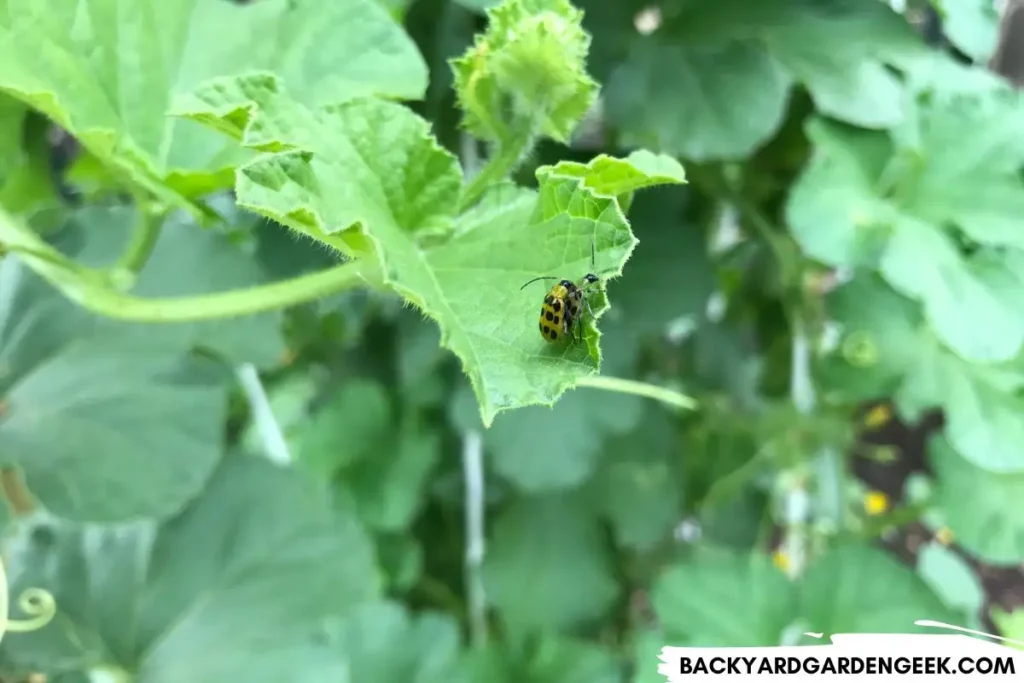
Pay particularly close attention to the flowers of your plants. On many occasions, I’ve found cucumber beetles nestled up in the flowers themselves, which gives them something to feed on while also providing some camouflage since cucumber beetles tend to be an off-yellow color.
Unfortunately for us, these feeding habits not only cause physical damage to the plants—which is annoying but usually not lethal—but also spread bacterial diseases.
This is where things go from bad to worse: You’ll never know if the cucumber beetles you see in your garden are disease spreaders or not. That’s why you’ve got to kill them fast!
When you apply DE to plants infested with cucumber beetles, it’ll work in two fairly immediate ways.
First, the abrasive particles will damage the exoskeletons of any adult cucumber beetles you hit with direct puffs of DE, creating tiny openings in their beetle armor.
Second, the highly absorptive DE will begin drawing out moisture from the beetles’ bodies through these openings.
Unlike neem oil, which takes 2-4 days to wreak biological havoc on insects’ internal systems, DE’s dual-action leads to dehydration and death in as little as 24 hours.
However, you’ve got to hit the cucumber beetles with a puff of DE. If you spray the plant with it but don’t actually get it on the cucumber beetles, you might notice that your results are less than expected.
Although DE is effective against adult cucumber beetles, it’s not so great when used on cucumber beetle eggs and larvae.
DE targets insects’ exoskeletons and their ability to retain essential body fluids, but eggs and larvae have a different physical makeup, so DE is not as effective in eliminating them.
This is why you’ll want to use DE in conjunction with other pest management measures to target all life stages of cucumber beetles. Read below to learn more about how I use DE in my garden plus other methods you can incorporate into your pest control routines.
Using Diatomaceous Earth to Stop Cucumber Beetles: A Step-by-Step Guide
Here’s my step-by-step process for using DE against cucumber beetles while also doing your best to protect beneficial insects:
| Choose Food-Grade DE | Not all DE products are created equal. Always opt for food-grade DE, as it is safe for use around plants, pets, and humans. |
| Perform Spot-Checks | Inspect your plants for ladybugs and other beneficial insects before applying DE. Whenever possible, you don’t want to harm these helpful bugs since they can assist in controlling cucumber beetles naturally. |
| Consider the Weather | Have you looked at the forecast for the next few days? If not, do that first before applying DE. There’s no sense in doing so if it’s going to rain in the next day or two. |
| Wear Protective Gear | Before applying DE, put on a mask, gloves, and even goggles to protect yourself from inhaling the fine powder or getting it in your eyes. Although DE is non-toxic, it can irritate your lungs and eyes. |
| Buy a Bulb Duster | Use a high-quality bulb duster, like the one sold by Dr. Killigan’s, to apply diatomaceous earth directly to areas where beetles are present. This tool ensures even distribution and precise targeting of the pests. |
| Use in Early Evening | The best way to avoid spraying beneficial bugs with DE is to apply DE as late in the day as possible when most pollinators are done with their work. I prefer doing so in the early evenings. It’s late enough to minimize the risk to beneficial bugs but early enough so that I can still see what I’m doing. |
| Note Pest Severity | If you’re dealing with an extreme cucumber beetle infestation, consider dusting the entire plant with a light layer of DE. This thorough application can help bring the situation under control, but only do so if you think there’s no other way to save your plant! |
| Reapply As Needed | DE loses its effectiveness when it’s wet or very humid outside. Reapply every 4-5 days, or immediately after it rains, to maintain its potency if cucumber beetles are still present on your plants. |
| Use Other Controls | For an even more effective cucumber beetle control strategy, combine DE with neem oil sprays. |
Neem oil contains azadirachtin, which can disrupt pests’ biological systems. Using neem oil in tandem with DE provides a powerful one-two punch against these destructive beetles.
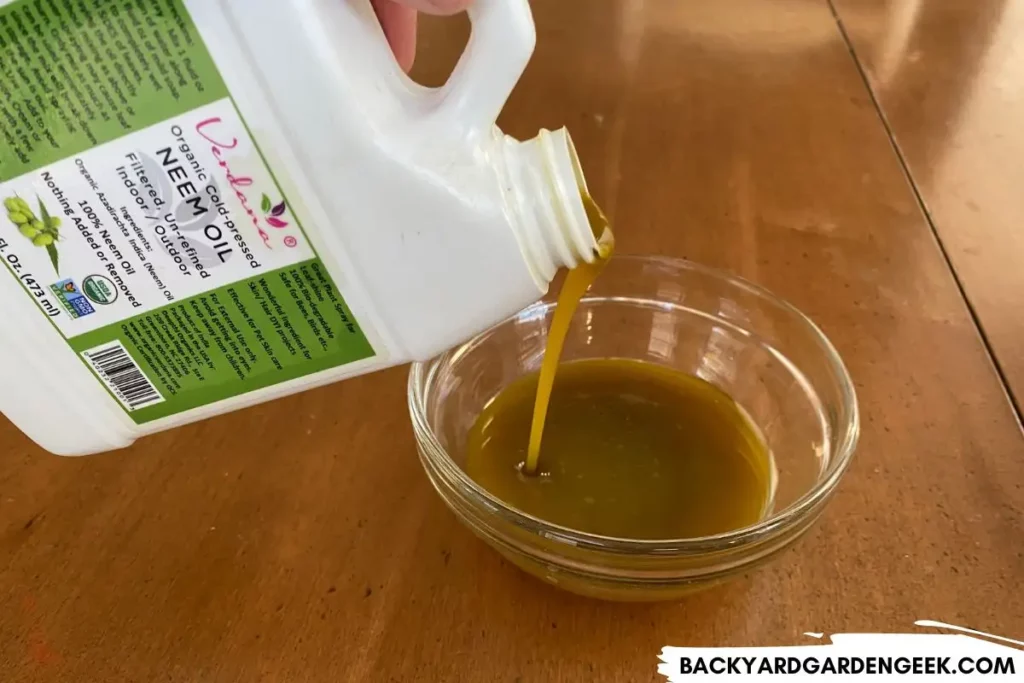
Just be sure to use neem oil first, then let it dry completely before applying DE. Otherwise, you’ll render your DE ineffective. I recommend applying neem oil on Day 1, then waiting until Day 2 to apply DE since that’ll give the neem oil plenty of time to dry.
Please be careful when using neem oil in your garden since it can burn your plants if applied incorrectly.
If you’d like to learn how to avoid doing so, check out these related articles:
- How Can I Make Neem Oil More Effective? My 10-Step Process
- How Long Does It Take for Neem Oil to Kill Bugs?
- Is Neem Oil Safe on Fruits and Vegetables? Food for Thought
- Neem Oil Plant Burn: Why It Happens + How to Avoid It
- Using Neem Oil Before a Harvest: The Do’s and Don’ts
- Using Neem Oil on Seedlings: 7 Things to Keep in Mind
By following the above steps, you can effectively use DE to control cucumber beetles while protecting the beneficial bugs in your garden.
Now that I’ve covered my step-by-step method, I’d like to share some info about common mistakes to avoid when using DE in your garden.
Using DE to Stop Cucumber Beetles: Mistakes to Avoid
One of the first and most common mistakes gardeners often make is waiting too long to attack cucumber beetles once they show up in your garden.
As I suggested above, It’s crucial to act promptly when you notice cucumber beetles since they’re vectors for plant diseases.
Delaying a DE application allows the beetles to cause more damage, weaken your plants, and potentially spread disease, so you need to address your cucumber beetle problem as soon as you spot them on your plants.
Another common mistake is applying too much DE unnecessarily, which can result in a thick coating on your plants.
You should definitely cover any affected areas with DE, but you don’t want to go overboard. Applying excessive amounts of DE can potentially block sunlight and impair photosynthesis, hindering plant growth.
Generally speaking, you should aim for a light, even dusting that covers beetle-infested areas without completely smothering the plant.
However, there might be times when you need to act very aggressively.
This happened to me once when flea beetles took over several tomato plants. I ended up covering them in DE since I felt I had no other good options.

The plants took some time to recover from the flea beetles and the extreme DE dusting I gave them, but they survived and continued producing tomatoes for me.
The timing of your DE application is also important. Avoid applying DE when it’s extremely humid outside or right before it rains.
DE’s effectiveness relies on its ability to absorb moisture, and high humidity or rain can cause it to clump together and lose its potency. For best results, apply DE when the weather is going to be dry for a few days. If it rains shortly after you’ve applied it, be prepared to reapply DE again once the plants have dried.
Next, consistency is key when it comes to using DE for cucumber beetle control. Failing to reapply DE at least once per week is another common mistake because it needs to be reapplied regularly to maintain its effectiveness and keep cucumber beetles at bay.
Finally, if you rely solely on DE for cucumber beetle control, you’re making another common mistake.
While DE can play a significant role in managing these pests, you’ll need to use other pest control methods in conjunction with DE applications.
As I mentioned earlier, neem oil spray is an excellent complement to DE since it targets pests’ biological systems. You could also consider using plant or row covers, introducing beneficial insects like ladybugs or lacewing, and keeping your garden tidy to prevent future infestations.
For simplicity’s sake, here’s a list of the common mistakes gardeners make when fighting cucumber beetles with DE:
| Mistake #1 | Waiting too long to address the cucumber beetle problem. |
| Mistake #2 | Applying too much DE when it’s not necessary to do so. |
| Mistake #3 | Using DE when it’s too humid or before it rains. |
| Mistake #4 | Applying DE once, then never reapplying it. |
| Mistake #5 | Not practicing multiple pest control strategies. |
If you avoid these mistakes, you can optimize your DE applications for effective cucumber beetle control.
But please remember that a well-rounded approach to pest management is crucial for maintaining a healthy, productive garden. With that in mind, let’s look at some other options for killing cucumber beetles.
What Else Can I Use to Kill Cucumber Beetles?
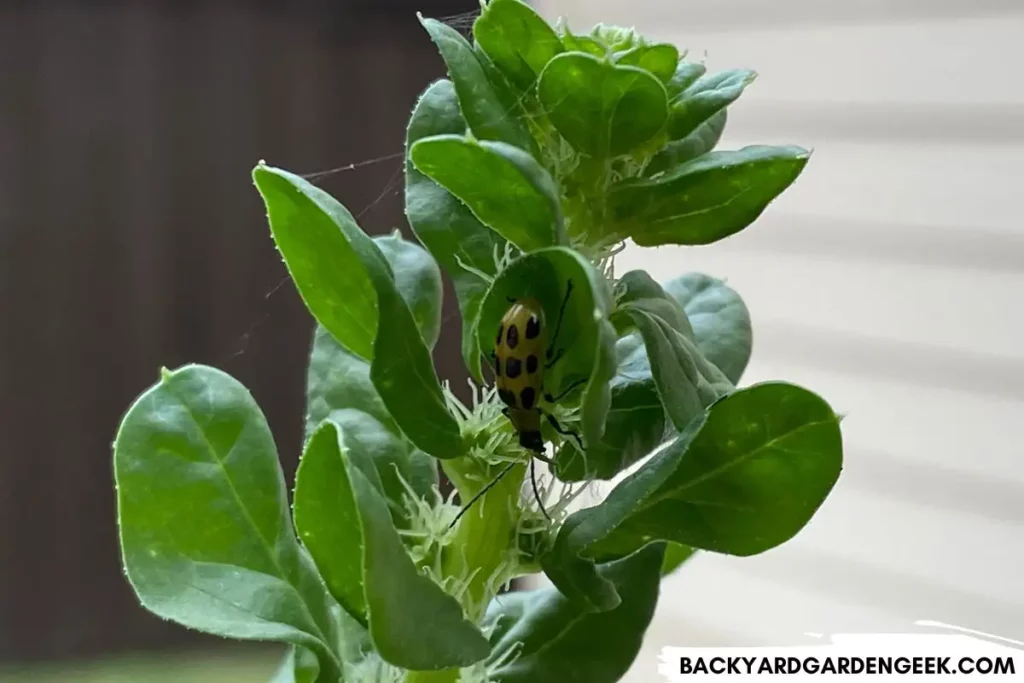
Just so you know, DE is not the only solution when it comes to killing off cucumber beetles.
Here are some other approaches you might consider:
1. Remove Eggs Manually
Always take a close look at your plants. If you see clusters of eggs on your cucurbits, you’ve likely got either cucumber beetles or squash bugs waiting to hatch.
Either way, take your finger and rub the eggs so as to dislodge and crush them. If you catch them in their egg form, you might be able to kill off 6-10 cucumber beetles in one pass!
2. Squish Visible Bugs
I know this sounds simplistic, but if you’ve got a very minor infestation—maybe just 2-3 bugs on the plant—I recommend putting on a pair of gloves and squishing them.
Just note that you’ll have to move fairly fast since cucumber beetles are adept at getting out of the way since they can scamper quickly and fly away.
But if you’re careful and quick, you can kill cucumber beetles without damaging your plants.
3. Use a Hand Vaccum
You’d be amazed at what a simple hand vacuum can accomplish in the garden.
I’ve used my hand vacuum to suck up cucumber beetles, leaf-footed bugs, harlequin beetles, potato beetles, squash bugs, and stink bugs!
If you’ve got a hand vacuum with a narrow nozzle, take it out to your garden, turn it on, and swoop down on those bugs. They’ll get sucked right up into the canister.
At that point, you’ve got 3 options:
- You can dump the contents of the canister into soapy water, which will kill the bugs in just a few minutes.
- You can dump it out on the ground and squash them with a brick or something else. This is messy but effective.
- You can leave them in the canister for 24-48 hours and wait for them to die. Once they’re dead, just dump the canister’s contents in your garbage bin!
4. Use Neem Oil Sprays
Neem oil, as mentioned earlier, can definitely help when it comes to fighting off cucumber beetles.
The key to using neem oil effectively lies in proper emulsification. Mix the neem oil water and a good emulsifier—my favorite is Dr. Bronner’s peppermint castile soap—then apply according to the manufacturer’s instructions.
This’ll ensure the oil disperses evenly when sprayed on your plants, maximizing its impact on the pests.
Here are a few articles on the subject if you’re interested in learning more:
- 9 Reasons Your Neem Oil Might Not Be Working
- How Long Does Neem Oil Last? A Complete Shelf Life Guide
- Rinsing Neem Oil Off Plants: Should You Do It?
- Using Neem Oil on Tomato Plants: An Easy, Step-by-Step Plan
5. Spinosad Sprays
Derived from bacteria that are known to kill pests—spinosyn A and spinosyn D, according to Oregon State University—spinosad sprays are another tool in your cucumber beetle control arsenal.
Spinosad is a natural insecticide that targets the pests’ nervous systems. Just be sure to apply spinosad to the affected plants as per the manufacturer’s guidelines, ensuring even coverage for optimal results.
6. Beauveria bassiana Sprays
For non-adult cucumber beetles, consider using a Beauveria bassiana spray…but only if you’re willing to spend a lot of money doing so (yikes!).
This fungus infects the larvae and pupae of the beetles, ultimately killing them. Apply the B. bassiana spray according to the product instructions, focusing on areas where the immature stages of the beetles are most likely to be found.
You can pick up either BotaniGard ES or BotaniGard 22WP, but both are rather costly, so personally speaking, this is not what I recommend doing. But I felt the need to mention it since it’s an option.
7. Cultivate Beneficial Predators.
Ladybugs, lacewings, and predatory wasps are natural enemies of cucumber beetles and can help keep their numbers in check.
I encourage these bugs in my garden by simply planting lots of different plant varieties.
This last year, I grew basil, beans, borage, broccoli, cabbage, chard, cucumbers, dill, feverfew, flowers (several kinds), kale, kohlrabi, lemon balm, lettuce, okra, oregano, peppers, potatoes, savory, sorrel, thyme, tomatoes, tomatillos, and many more!
When you create a garden ecosystem that’s incredibly diverse, you encourage all kinds of beneficial bugs to show up and help out, giving them a variety of plants and flowers to choose from.
You can purchase ladybugs and lacewings from online retailers, then release them directly into your garden, but there’s no guarantee that they’ll stick around once you do unless you’ve got lots of attractive plants where they’ll want to make their home.
8. Maintain a Tidy Garden
Finally, if you maintain a tidy garden—getting rid of dead debris and cleaning up around the base of your plants as they shed dead foliage—you can help keep cucumber beetles under control.
Keep your garden free of fallen, rotting leaves, plant clippings, and rotting fruits since these can provide hiding spots and breeding grounds for unwanted begs.
Regularly weed your garden and remove any yellowing or dead plant material to cut down on anything that’ll attract cucumber beetles.
If you end up using some of these alternative methods along with DE applications, you’ll make it much easier to manage cucumber beetles before they take over or spread disease, keeping your plants as healthy and productive as possible.
Final Thoughts About DE and Cucumber Beetles
As I mentioned earlier, tackling your cucumber beetle problem early on will prevent these pests from multiplying, overwhelming your plants, and spreading diseases.
DE is an effective, natural, and non-toxic way to do so as long as you understand how it works and you’ve given lots of thought to when, where, and how often you apply it.
But with a little diligence and the right knowledge, you can stop your cucumber beetle infestation and enjoy a cucumber beetle-free garden.
On that note, if you’d like to learn more about how I’ve used DE in my garden over the years, I recommend taking a look at these related articles:
- 5 Reasons to Mix Diatomaceous Earth with Soil
- Can Diatomaceous Earth Harm Plants? What Scientists Say
- Can You Put Too Much Diatomaceous Earth on Plants?
- Diatomaceous Earth vs. Neem Oil: Which Should You Use?
- Using Diatomaceous Earth: Do I Need to Wear a Mask?
- Using Diatomaceous Earth as a Fertilizer: Will DE Help?
